This web page contains the logs of the sixth leg of a trip that I took with S/Y Thetis from Greece to Tunisia and back. The leg covers 3 days of sailing from Monastir to Sidi Bou Saïd followed by a 5-day period of land exploration in North Tunisia using the marina of Sidi Bou Saïd as our point of departure. Places visited are: Hammamet, Kelibia, Cap Bon, Sidi Bou Saïd, Carthage, Tunis, Dougga, and Bizerte.
The logs are illustrated with maps and photographs, and also includes some historical and geographical descriptions of the places visited as well as several links to other related web sites.
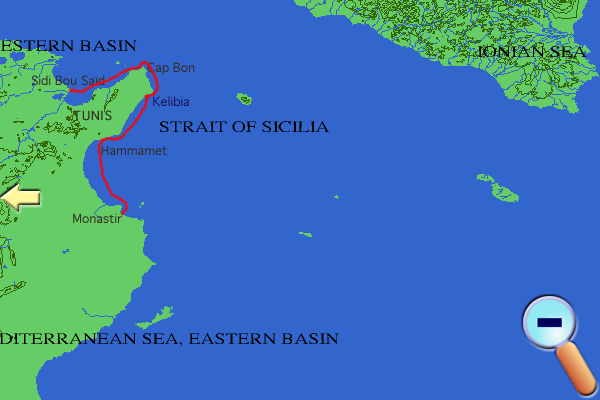
Wednesday May 30 2001, Day 27
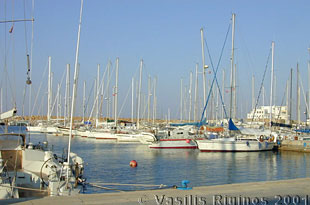
We prepared for departure. In Tunisia, a yacht cannot leave a harbor without police clearance, so I had to go to the police. There I got into an argument about wheather or not I had paid the marina. The policeman refused to accept my receipt because it was dated yesterday. I tried pointing out to him that the price I paid did cover yesterday but he would not have it. The Capitanerie had not yet officially opened and the man manning its office had no authority. Eventually they had to call the Harbor Master, at his home, before they would accept my receipt. Now that the police was satisfied I had to go to the Coast Guard, at the other end of the harbor, for their blessing. They were, however, very friendly. All in French. After we made small talk with my broken French, they stamped the papers, which I took back to the police, who stamped the papers and gave me the blasted transit-log suitably sanctified by all the seals.
Before departing, I flushed the fresh water tanks and re-filled them as well as the sun-shower. We cast off from Monastir at 0805, our destination: Hammamet. There was no wind whatsoever. We motored. Later the wind picked up a little to 5-10 knots SE and we opened the headsail which increased our speed by ½ knot.
We arrived in Hammamet [36° 23.7' N 10° 36.5' E] at 1420 having covered 35.2 M. We anchored in the lee of the promontory at 4 m depth without any problems other than that several boats kept coming very close to us looking at the bottom. It turned out that they were looking at a wreck uncomfortably close to us. We re-anchored. There was a terrific swell. We inflated and launched the zodiac. This was the first use of the anchor and zodiac since departing from Sifnos.
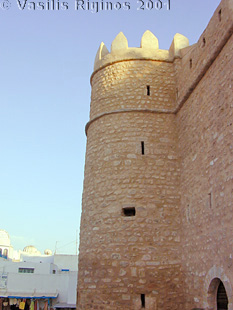
Later we went ashore and visited the town. The Medina is nice with shady narrow streets full of stores. It is a picturesque town but too touristy. The beach here is lovely and wide stretching for miles with many fishing boats resting on its extremely fine sand. We sat on the beach and enjoyed the beautiful sunset. The fishing boats are all very run down. Nothing like the freshly painted and well maintained boats of Malta.
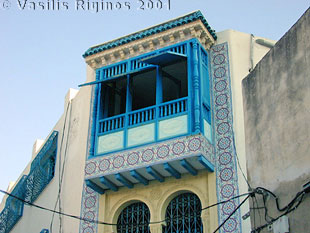
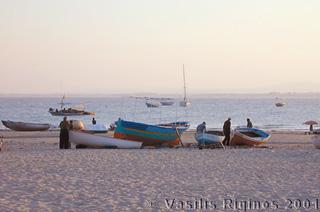
Back on board, I flushed the alkaline solution from the watermaker and replaced it with an acid solution which will soak for another 36 hrs. This should do the trick and clean its membrane.
Alice, despite the heavy roll, made a pasta alla puttanesca, but I managed to make a messy spill while opening the wine bottle. Despite that, we had a nice supper in the cockpit.
Thursday May 31 2001, Day 28
We got up early and by 0730 we were underway heading for Kelibia towing the dinghy behind us since the sea was fairly calm. We motored as there was hardly any wind, 1-6 knots form the SE.
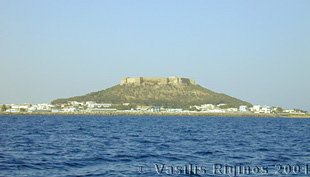
Later, about 1030, the wind increased and we raised the mainsail shaking off the reefs and opened the headsail. This allowed us to sail at about 5 knots until we were at the entrance of Kelibia harbor. We entered the harbor at 1430 but it was full, mostly with fishing boats and a few navy and coast guard gun-boats. There was hardly any room left except to come alongside a patrol boat. The quay looked very rough and there was a strong smell of stale fish pervading the area. We decided not to stay at Kelibia, as we were originally planning, but to continue for another 15 M north to an anchorage under Cape Bon which sounded attractive from its description in the North Africa Cruising Guide.
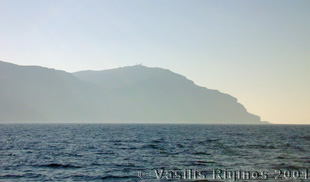
We exited the harbor and raised the mainsail again but the wind was only 8-10 knots SE, on our tail, and the headsail was flapping so we had to roll it in and motor-sail. Two hours later the wind died and we lowered the flapping sail and continued motoring. After rounding Cap Bon the situation completely changed. A furious S wind was blowing at 18-30 knots and the sea was angry and full of foam. We slowly motored to the protected anchorage [37° 04.8' N 11° 02.2' E]. There were no waves but the wind was howling. We dropped our anchor at 1815. Our distance from Hammamet was 54.6 M.
Despite the wind we had showers and an ouzo inside the cabin because the wind made the cockpit very uncomfortable. Alice made a tasty rice with curry which we had bought at Monastir. We went to bed to the sound of the wind. Our radio stopped working.
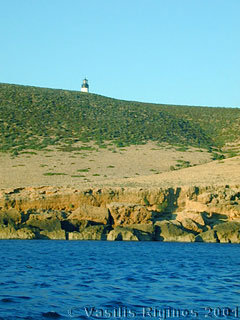
Friday June 1 2001, Day 29
The wind howled all night but by the early morning it slowed down and shifted W. I was concerned that the boat may drift towards the rocks but she was stable at a depth of 4.2 m. Anyway, I got up several times to check. It was after daylight when I realized that the chain was wrapped around a large rock which is what held us off the lee shore.
We raised the anchor without too much trouble and departed from Cap Bon at 0725. Once we were about one mile off, there was almost no wind, just a light 5-8 knot W breeze. Motoring was the only option. While we motored I completed the service of the watermaker but still no fresh water. I also, on a hunch, completely disconnected the radio and left it without power for one hour. When I reconnected it, it worked. It must had been a software related fault and the lack of power caused it to reset its memory.
Near the cape there were many nets and we had to change course several times to stay away from them. Later the wind veered NW but it was still too weak for even motor-sailing.
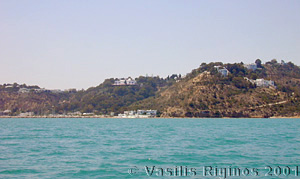
We arrived at the Sidi Bou Saïd marina [36° 52' N 10° 21.1' E], at Cape Carthage at 1335 after 33.4 M. Sidi Bou Saïd is the yacht marina for the city of Tunis. We tried raising the marina on the VHF but, as usual, there was no response. Our entry to the marina was rather dramatic. They were dredging the entrance and we had to squeeze between the shallow sand bar and the dredge barge. We barely made it without running aground. Fortunately an attendant directed us to a berth. It was very hot. We wedged between two sailboats, the attendant gave us a mooring line and caught our stern lines. All of a sudden there we were, in Tunis. It was hot! We quickly deflated the zodiac and stowed it in the left cabin. We covered the sails and put up the tent. It was hot! We were exhausted and we fell asleep in a deep stupor.
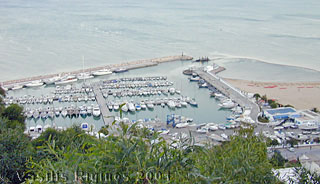
In the evening we walked to the Capitanerie and filled several forms. The shower/wc facilities here are rather bizarre: they operate from 0800 to 2000 and before using them you must find the lady attendant from whom you borrow the key after giving her the inevitable tip. Appraising this situation we concluded that we just had to use Thetis’ facilities. We would only add an infinitesimal amount to the already very dirty water. AC and water are readily available at the pier and we connected right away. It looked like the fuel dock would be hard to approach because of the dredging operations. The GSM signal strength was variable and it was hard to receive data. Most of the boats in the marina were Tunisian. The other boaters were not very friendly, they hardly looked at you and they seemed to singularly lack any curiosity about a new arrival that flies a strange flag. This was in great contrast to the gregarious boaters in Greece and Turkey.
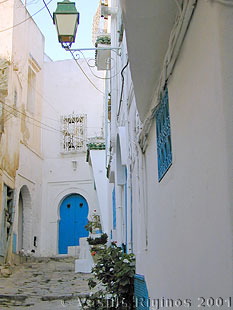
After hot showers aboard Thetis we walked up the very steep path (20-30 minutes) to the famous village of Sidi Bou Saïd. Considering that this is one of the most celebrated and wealthy suburbs in Tunisia, we were amazed at the amount of refuse along the path. The village of Sidi Bou Saïd is indeed charming although architecturally not very remarkable. What contributes to its charm are the elaborate doors, the iron grill work, and the vibrantly multi-colored bougainvilleas.
We sat at a wonderful café with a terrific view of the marina and the whole gulf of Tunis where we had some minted tea sprinkled with pine nuts. We also bought a bouquet of jasmine which seemed to be de rigeur here. What we did not do was to smoke a nargile (water pipe) which at least half of the predominantly male clientele were doing. I was sorely tempted. It was a great place to be during the sunset. We fervently wished for an ouzo, a raki, or a glass of wine but none of these are served in any of the attractive cafés in Tunisia. Strange lands, strange customs! For instance, we had noticed that neither waiters nor passers-by ever looked at you straight. Even while talking to you they averted their eyes away. By the way, most waiters have an extremely sad expression to the extent that many times I felt the urge to commiserate and express my sympathy for the recent lost of their relative.
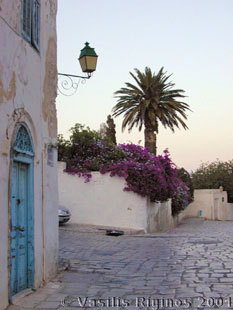
We looked into several restaurants in the town but none seemed to have any customers and we could not make up our minds where to eat. Finally we decided to walk back down to the marina and try our luck at the highly recommended Le Pirate. It was in a marvelous garden full of palm trees. The inside, where the tables were, was also attractive. Only one other table was occupied and later a third. We had some mechouia salad (chopped grilled vegetables and tuna), grilled squid, and a grilled dorado fish. Delicious, washed down with a passable Tunisian rosé wine. We finished with fresh strawberries which were very tasty and naturally sweet. No resemblance to what passes for strawberries in the US. This great meal set us back 60 TD (~$43) but it was worth it.
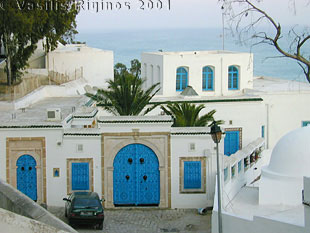
Saturday June 2 2001, Day 30
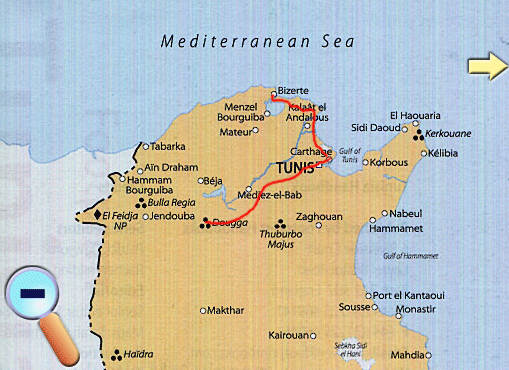
The day begun by washing down the boat after which we went exploring. The man at the Capitanerie was different from yesterday’s and was genuinely friendly, not sad at all, and spoke reasonable English and gave us instructions how to go to Tunis. First we must go to the TGM (local train for Tunis) station which is up the hill. We started on foot. It was hard going up the steep hill under the strong sun. At the station we bought 2 round trip tickets for 2 TD, and boarded the train. Just like in the train from Sousse to Monastir, our fellow passengers seemed to avoid being near the two foreigners.
Tunis is the end of the line. We got off and bought some very tasty crissini (bread sticks) from a stand and walked down the Avenue Habib Bourguiba. This is the main avenue in Tunis referred to by the ever enthusiastic guide books as the Tunisian Champ Elysées. It is a very far cry from the original, especially now when it was completely torn up by heavy construction. The whole avenue was a dirty, dusty place lined by unremarkable concrete block buildings. We found the Tourist Office where they had many brochures covering all the regions of Tunisia. They were available in several languages. We asked for directions to the Post Office.
The Post Office was only one block away. There we bought stamps for the US and other places from a very friendly lady clerk. She actually welcomed us to Tunisia! We then took a taxi to the famous Bardo Museum. The ride was long and hot through very heavy traffic and thick exhaust fumes. I got very dizzy. We were hoping to eat lunch at the museum which according to the guide books has a cafeteria. Nothing could be further from the truth. After paying the entrance and photographing fees, 9.5 TD, we discovered that the “cafeteria” was actually a counter with coffee, tea, soft drinks, ice cream, cookies, and bags with potato chips. That was all. I ate some ice cream and cookies and had a coke after which I felt much better although I was still hungry having had no breakfast.
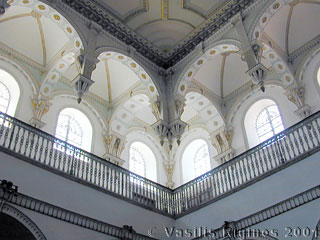
The Bardo Museum, other than its “cafeteria,” is indeed a great museum. It is housed in a 19th century palace that belonged to a wealthy pirate-Bey. One marvels there after seeing one magnificent Roman mosaic after another. It is endless and very exiting. In addition to the mosaics, they have a very surprising exhibit from the shipwreck of a boat ferrying loot from Athens to Rome. There are two marvelous bronze statuettes of Hermaphroditus, two intact wooden beds, etc. The only disappointment was that most of the Punic (Carthaginian) exhibits were closed due to remodeling.
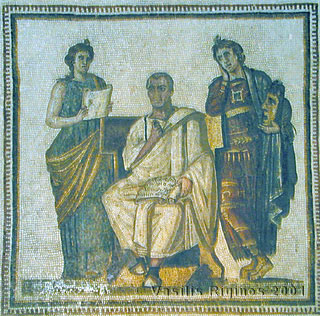
Bardo Museum
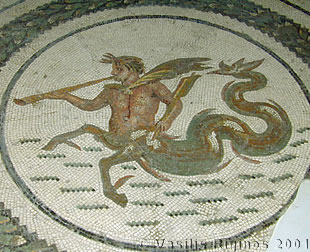
A Triton |
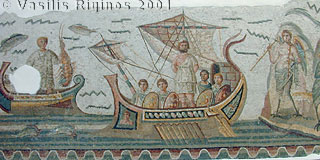
Odysseus Listening to Sirens |
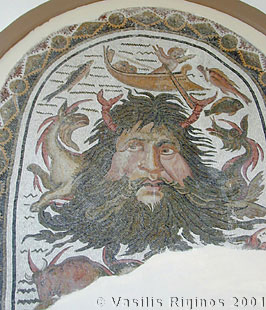
Poseidon |
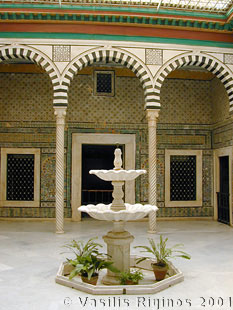
The Inner Courtyard |
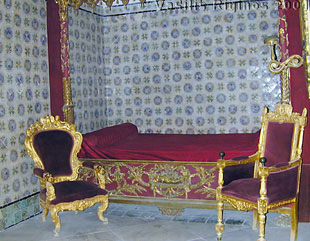
Bardo Museum
Several hours later we emerged from the museum and took a taxi. We asked the driver to take us back to Avenue Habib Bourguiba but he wanted to take us elsewhere. Eventually we convinced him that Avenue Habib Bourguiba was the only place we wanted to go. When we got there he asked for 5 TD, 2 more than we had paid before. As we were famished we looked for a place to eat. After several futile attempts, it was late, we ended in a strange, dark restaurant full of beer drinking men and 2-3 heavily painted ladies. We ate several salads: Tunisien, mechouia, and an octopus salad. They were delicious and so was the cold beer.
After satisfying our hunger we walked to the TGM station and took the train back to Sidi Bou Saïd. Two young girls were sitting next to us. They did not move but seemed very uncomfortable in our presence. When a young dark skinned man entered the car and sat next to us the girls got up and changed seats. It is hard to understand this kind of behavior because other than that the girls looked very attractive and not atypical to teen-age girls anywhere else in the world.
At Sidi Bou Saïd we bought some provisions and descended to the marina. We were exhausted. I finished the Greek book that I was reading: Κουστούμι στο Χώμα - A Suit made form the Earth by Ioanna Karystiani. It is the story of a young biology researcher from Crete who lives in Frederick, MD. He returns after many years to Crete and discovers the bloody history of his family which has been totally consumed by vendetta. It is a slow and depressing but at the same time fascinating book.
Alice made a spaghetti with a fresh tomato sauce wonderful in it simplicity.
Sunday June 3 2001, Day 31
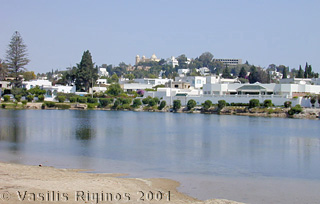
Today we set out to explore ancient Carthage which is not too far from the marina. We took a taxi to the Punic Harbor. It is very hard to see where and how the old Carthaginian ships were harbored. But in a small building, the Antiquarium, shown to us by the very friendly guard, there were several drawings and a model, which coupled with some imagination, allow one to visualize this most remarkable home port of the Carthaginian navy. Carthage was the major sea power of the western Mediterranean for several centuries until it was destroyed by the Romans. The ships were pulled out of water and housed in boat houses built around a circular lagoon.
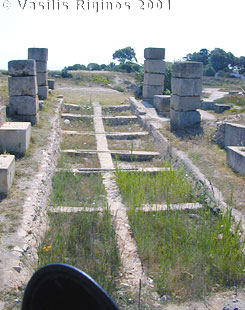
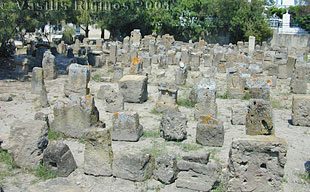
From the Punic Harbor we walked to the Salammbo Tophet where we saw another, much more sinister, side of the ancient Carthaginians. Here was the burial ground, the Tophet, of the many children sacrificed to the goddess Tanit and the god Baal. It seems that these were only male children from 4 to 11 years old, the sons of prominent families. Their bodies were burned and their ashes were placed in small clay urns which were buried in the ground. The burial place was marked by a stone stele (a flat tombstone) embellished with the sacred signs of the god or goddess. There were hundreds of these stelae. A very intriguing culture about which we actually know very little. A thriller novel A Spy for Hannibal written by our friend Elisabeth Craft gives an excellent evocation of this child sacrificing culture.
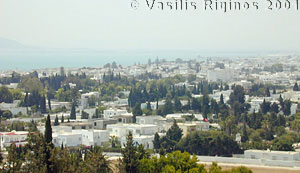
We then walked to the TGM station and took the train for a few stops after which we had a long uphill walk to the Carthage Museum. It is situated on the top of Byrsa Hill from where one has a very good view of the whole Carthage region and the Bay of Tunis. The museum has a large collection of Punic objects, two sarcophagi of great detail, lots and lots of pottery and amphorae, and some remarkable glass miniature heads—very beautiful in full color. It also has a good Roman collection with more mosaics etc. In particular there are two lovely Roman statues of a charioteer and his wife—recently unearthed by Alice’s friend Naomi Norman of the University of Georgia at her excavation of the cemetary near the hyppodrome.
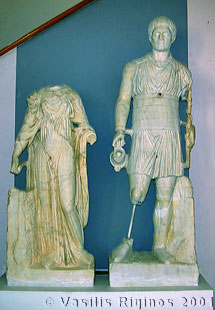
Roman Charioteer & Wife |
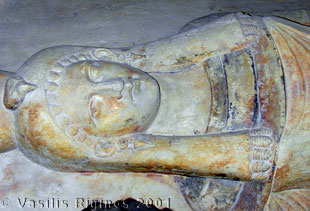
Punic Sarcophagus |
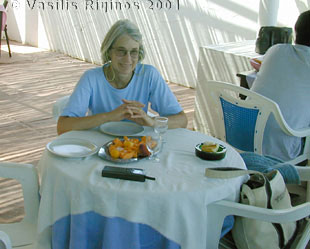 When we got tired of walking through the museum we took a taxi back to Sidi Bou Saïd but did not stay in the town, instead we had the taxi drive us to the beach, just south of the marina, to the Amphitrite restaurant. Once again the driver tried to overcharge us. The food was delicious: a Niçoise salad, Fatima’s fingers (pastry dough stuffed with squid, potato, and herbs), and grilled red mullets. The whole beach, being Sunday, was full of people, mostly young men and boys. There were precious few females. The whole area seemed to be full of large groups of pre-teen boys running wild all over. The restaurant was full of middle class families. It was a leisurely and most enjoyable lunch.
When we got tired of walking through the museum we took a taxi back to Sidi Bou Saïd but did not stay in the town, instead we had the taxi drive us to the beach, just south of the marina, to the Amphitrite restaurant. Once again the driver tried to overcharge us. The food was delicious: a Niçoise salad, Fatima’s fingers (pastry dough stuffed with squid, potato, and herbs), and grilled red mullets. The whole beach, being Sunday, was full of people, mostly young men and boys. There were precious few females. The whole area seemed to be full of large groups of pre-teen boys running wild all over. The restaurant was full of middle class families. It was a leisurely and most enjoyable lunch.
We walked back to Thetis where we took a rest under the tent. In general here, unlike in other marinas, our fellow boaters are not such a friendly lot. As they walk by they stare at us but when we either greet them or smile they do not reciprocate but completely ignore us. I am getting kind of tired of greeting these rude strangers. Just as these thoughts came to my mind the people from the small sailboat next to us introduced themselves. The man is Tunisian and US educated and his wife is German and used to work in the World Bank in our home town Washington, D.C. You cannot ask for friendlier people. The marina here, unlike the one in Monastir, has very limited facilities for visiting yachts: very basic shopping, no bank or ATM. Taxis are available and when honest, about 50% of the time, reasonable. The Capitanerie is helpful but ineffective. They have no change, accept no credit cards, nor foreign currency.
In the evening we walked up the hill back to Sidi Bou Saïd. This time we tried another path, very steep and isolated. On our way up, we were overtaken by a band of 12-14 year old boys, they must have been 8-10 of them. Now we had observed that most Tunisian boys for some reason are fascinated by Alice. So we were not surprised when the band stopped to stare at her. What we were not expecting was their vulgar gestures and loud vocalizations. They actually demanded to be paid 1 TD each. I got furious and told them that I saw no reason why we should reward their rudeness. They started making obscene gestures at Alice but I raised my voice, in Greek, and they left. It was a scary and very unpleasant experience.
We looked in vain around Sidi Bou Saïd for an ATM but none were to be found. We walked back down and had a light snack aboard Thetis.
Monday June 4 2001, Day 32
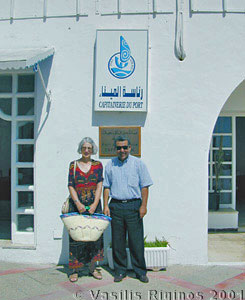
As soon as the Capitanerie opened we went to ask for help to arrange for transport to Dougga a major Roman site west of Tunis. It was the day that the pleasant, English speaking Harbor Master was on duty but it was also a Tunisian holiday. He informed us that there are two types of taxis: small and large. The small ones are only allowed to take passengers within a limited radius and cannot take us to Dougga. The large ones, that could, would cost us about 160 TD round trip. The better arrangement would be to rent a car which will cost about 80 TD per day. He called a car agency but they did not answer. He advised us that he will try to secure a car for us by this evening so that we could go to Dougga tomorrow.
While we were in the Capitanerie a very pleasant young couple from a Spanish sailboat came in. They had tried to depart the marina yesterday but their boat that draws 2.5 m ran aground near the dredge at the entrance of the marina. Today, the dredge was blocking the entrance and they came to ask the Harbor Master when they may be able to depart. They have been away from Spain for a year and they had spent the winter in Greece. Now they were on their way back. They told us that the best store to get provisions is the just opened Carrefour—a large and well known French chain. The store is about 5 km from Sidi Bou Saïd.
Not having anything better to do, we took a taxi to the Carrefour. On the way we stopped at a bank just in front of the President’s Palace and took some money out from the ATM. The Carrefour was gigantic. We loaded a cart with provisions. Cheeses are not so common in Tunisia but here there was a large display. While arguing between us, in Greek, about which cheeses to buy, a customer asked us, in fluent Greek, if we were Greeks. He introduced himself: Dimitris Xylinas. He heads the Total fuel company in Tunisia. He offered us a ride in his car back to the marina.
On the way to the marina we stopped at his house in Carthage. It is a majestic villa enclosed by an almost Roman garden and an atrium. The house is provided by his company along with a cook, a gardener, and a night watchman! Dimitris came aboard Thetis and we had a nice conversation. He too would like to cruise under sail when he retires. He was born in Chios to a refugee family from Istanbul. He has lived most of his life in Paris. Today being a holiday his office is closed. He has only been here in Tunisia for a few months and likes it.
After Dimitris left and we rested, we walked back to the Capitanerie. The Harbor Master tried again but still he could not find a car rental company to answer their phone. He suggested that we take a taxi to the airport where all the car rental companies have booths. We did so. We finally got a car for 120 TD for two days.
We drove back to Thetis where we prepared for dinner an elaborate potato salad to go along the already grilled chicken that Alice had bought at the Carrefour.
Tuesday June 5 2001, Day 33
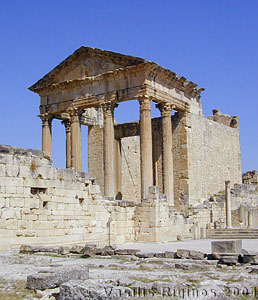
We got up early and by 0630 we were on the road to Dougga. By following the instructions of our friend the Harbor Master we were able to avoid most of the morning traffic and soon Tunis was behind us. As usual when we arrived at the town of Teboursouk, which is right before Dougga, the road signs deserted us and again, as usual, our tourist guides (Footprint Tunisia Handbook: The Travel Guide and Essential Tunisia) and maps were of no help.
Eventually we did find the site. It is indeed spectacular. It is surrounded by rolling hills cultivated with acres and acres of wheat and small olive trees. We spent several hours walking, all by ourselves as there was no one else within sight, through the paved Roman roads to temples, baths, the Roman Theater, and a Punic Mausoleum. The day was still young and not stifling hot yet so the walk was pleasant and there were plenty of shady spots where we stopped to rest, read our guides, and admire the view.
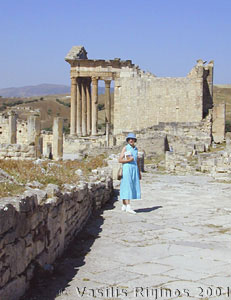
A Roman Street |
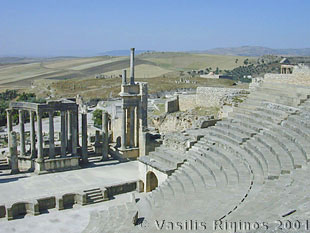
The Roman Theater |
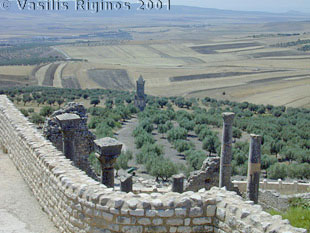
View |
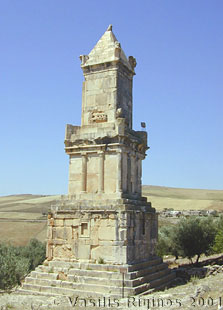
The Ateban Mausoleum |
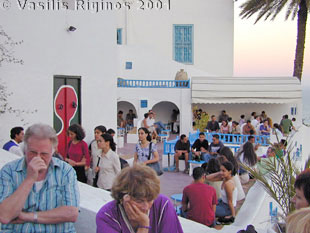
We drove back to the marina for an afternoon rest aboard Thetis. In the afternoon we drove up to Sidi Bou Saïd where we bought several packets of dates to bring back with us to Greece as gifts. We then sat at our favorite café, the Coté Sidi Chabaance, and had our customary mint tea with pine nuts while enjoying the view and the sun set. We then walked to the Le Charguie restaurant where we had a nice cous-cous dinner. All together a good day.
Wednesday June 6 2001, Day 34
Today my nephew Nicky Iliades is arriving to sail back with me to Greece while Alice will be flying tomorrow to Athens. To prepare for Nicky’s arrival we rearranged the left cabin which we had been using as our storage room. During this rearrangement I discovered, to my great dismay, that one of the bolts that holds the stuffing box and ultimately the propeller shaft in place was completely loose. I tightened it. Phew!
We wanted to take advantage of the rented car and possibly see the country N of Tunis. So we took a drive to Bizerte, my choice. It was not a very long drive but it definitely felt so. It was hot and there were too many slow trucks on the road. It was not pleasant! Bizerte seemed nice enough but we were too hot and tired to appreciate it. We drove along its esplanade and then turned back.
On the way back to the marina we stopped at a popular road restaurant that specializes in mechoui—grilled meat. We ordered a portion of mechoui and a mechouia salad (grilled vegetables in oil). Both came with a round flat bread, something like pita, but no other utensils. We ate with our fingers. It was fun. The bread and salad were delicious but the meat was too greasy for our taste.
Back on Thetis Alice started packing. By 5 PM we were back in the car driving to the airport to meet Nicky’s flight due at 6. On the way, we stopped once again at the Carrefour and got some more of the grilled chicken for dinner and some bottles of Tunisian wine to take back to Greece. In this gigantic store as well as in all the other stores we have looked we were unable to find two items: paper napkins and crispens (Swedish toasted bread).
At the airport, after parking, we went to the luggage area and there, ahead of time, stood Nicky. He was tired from his long trip but glad to see us. We drove back to the marina. We had trouble parking. The parking lot is “protected,” during the day but not in the evening. There were at least 3 guys operating a bar blocking access to the lot. They demanded 2 TD for parking. The fact that we have a boat and we are paying a stiff berthing fee cut no ice. In general I find that the whole set up of the Sidi Bou Saïd marina is not very convivial to visiting yachts.
On board Thetis we got Nicky installed. I called the car company and they came promptly at 8 and took the car. We had dinner aboard: grilled chicken and a rice salad.
Thursday June 7 2001, Day 35
Alice left Tunisia for Athens. Her departure was somewhat problematic. We carted her bags from Thetis to the marina exit and from there to the parking lot. There were no taxis to be seen. While Alice stood by her luggage, I went back in the marina and the Capitanerie. Our English speaking Harbor Master was not on duty today. Instead his very sad looking understudy was there. I asked him, in my atrocious French, to please call a taxi to take my wife to the airport. I explained, or at least tried, that we went outside but there was no taxi and that she is standing there with her bags. He did not believe me. He, after very carefully arranging his desk, followed me to the parking lot and made certain that Alice was indeed waiting for a taxi. Then, we walked back to his office and after some further rearrangements of his desk he made the call. He then very carefully cut a blank sheet of paper in half and scribbled on it the number of the taxi that was due to arrive in “Douze minutes.”
After Alice boarded her taxi I walked back to Thetis and rearranged things once again so that now the front cabin, which she had vacated, will be our storage room. With the help of Nicky, we put the already deflated zodiac in the cabin etc. Then it was the engine’s turn. I changed the oil and oil filter. Then I changed the two fuel filters, bled the lines and re-started the motor. When we were done with these chores it was past 11:30 and we prepared lunch to be eaten in the cockpit before going sightseeing.
The crew of a caïque, docked just few boats away from us, brought a live lamb tethered on a rope which they tied on a cleat. While we were eating, a sizable group of men gathered on the pier and proceeded to slaughter the beast, pump it up with their inflatable’s air pump, skin it, and cut it into pieces which they took aboard the caïque. This spectacle did ruin our appetite. Later the owner of the caïque came over to invite us to a feast that he is giving tomorrow in honor of his daughter who is returning from England after completing her first year at the university, hence the lamb. He is a Berber and very personable. He is in the shipping business and has many dealings with Greek ships. This was our first and last social contact with a native Tunisian. It is a shame that we will be gone by the time of the feast and will lose this opportunity.
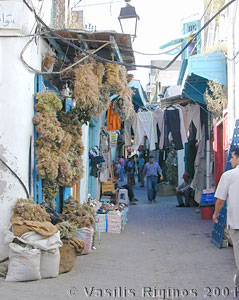
At around 3 PM we took a taxi to the TGM station and boarded a train for Tunis. It was packed and Nicky and I were separated. Right in front of Nicky’s eyes, as the train approached a station, a young man snatched the necklace off a young lady sitting near Nicky and dashed out of the train disappearing into the crowd. Nicky was shocked while I saw nothing. At Tunis we took a taxi to the Medina or Souk (market place) and wandered in the narrow streets for a while. Here there used to be the largest slave market in the Mediterranean where all the captives of the Barbary pirates were sold. One can feel the presence of untold human misery. I bought some saffron. Then another taxi and the train and back to the marina.
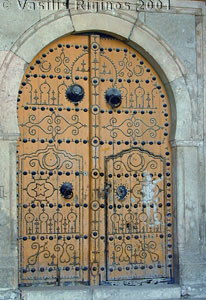
Wooden Door in Tunis |
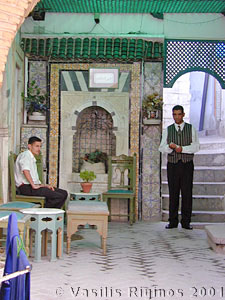
A Café at the Souk |

After showers and a rest we walked up to Sidi Bou Saïd and to the Coté Sidi Chabaance café where Nicky was introduced to the pleasures of sipping pine nut flavored mint-tea while watching the sun sinking in the bay of Tunis. Then, so that he would not leave Tunisia without sampling the local specialties, we walked to the Le Charguie restaurant where we had a sumptuous dinner of brik (eggs wrapped in filo), mechouia (grilled vegetable salad), and cous-cous. By the time we finished eating the full moon had risen. It illuminated our descent to the marina.
Our plan was to depart from Tunisia tomorrow. I was anxious about the weather. The last forecast posted on the Capitanerie was from June 4. Neither the Navtex nor Alice’s short-wave radio had received a weather report. So, in desperation I called Nikos in Greece and asked him to look up the weather on the Internet for us.